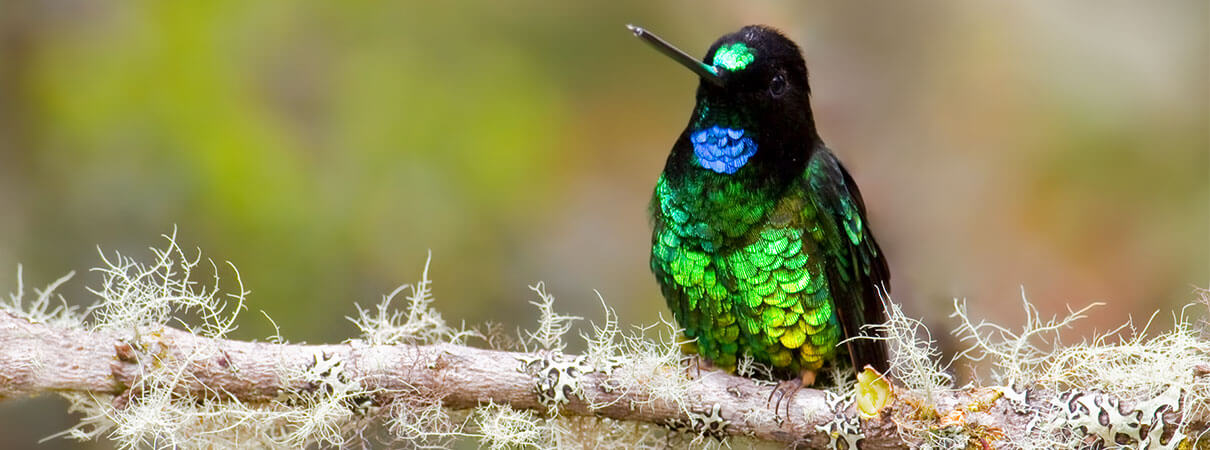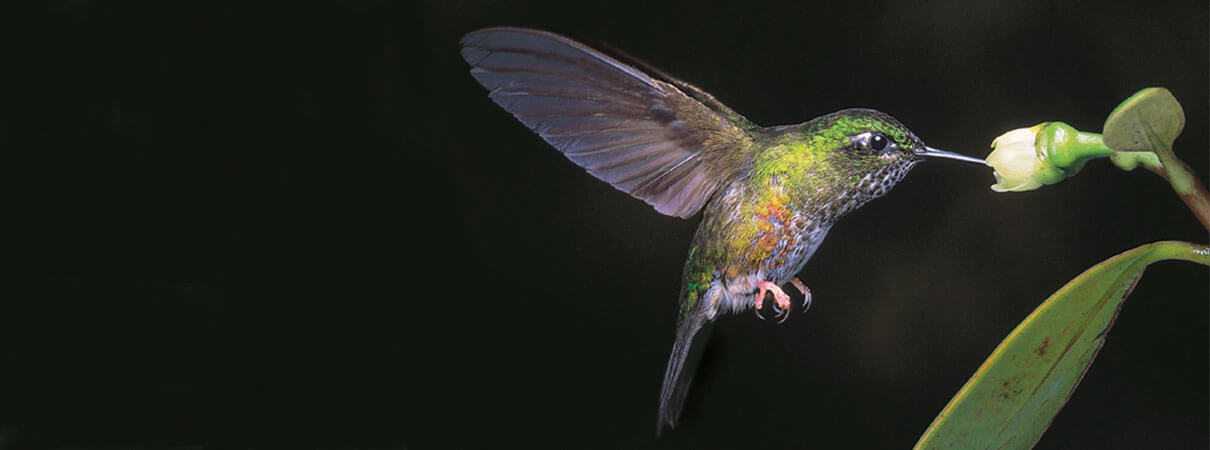Five of South America's Rarest Hummingbirds & Where to See Them
Our "Top Five Rediscoveries of Lost Birds" in the Americas include a spectacular Colombian hummingbird, the Blue-bearded Helmetcrest. This and other scientific advances have spurred conservation action by American Bird Conservancy and our South American partners, ensuring the survival of some of the avian world's most beautiful species.
Here are five of the rarest hummingbirds in South America — all birds that we've helped to protect — and where you can see them.
1) Glittering Starfrontlet: Colibri del Sol Nature Reserve, Colombia

Glittering Starfrontlet. Photo by Dubi Shapiro
The male Glittering Starfrontlet is a large hummingbird with a black head bejeweled with an iridescent emerald patch on its forehead, a deep blue throat patch, and a glittering greenish gold belly.
Previously known as the Dusky Starfrontlet, this hummingbird of Colombia's western Andes was known only from a single specimen collected in 1951 until it was rediscovered near the Colombian city of Urrao in 2004.
ABC and partner Fundación ProAves helped protect the rediscovery site, known as the Páramo de Frontino, by establishing the Colibri del Sol Nature Reserve in 2005, which now spans more than 11,320 acres. Thanks to these efforts, the Glittering Starfrontlet can now be seen visiting feeding stations within the reserve.
Three additional subpopulations have been found since, including one in Tatamá National Park, but the areas inhabited by all populations remain small. The Glittering Starfronlet's total population is estimated to be fewer than 250 individuals.
2) Colorful Puffleg: Mirabilis Swarovski Nature Reserve, Colombia

Female Colorful Puffleg. Photo by Luis Mazariegos
The male Colorful Puffleg is indeed colorful, with predominantly emerald green upper parts contrasting with a blue belly, white puffs of feathers above its feet, reddish feathers underneath the base of its tail, and golden green undersides to its tail.
This Endangered hummingbird was known from four museum specimens collected in 1967 before being definitively reconfirmed near the original discovery location, which is now within Colombia's Munchique National Park, in 1997. It's estimated that only between 250-999 mature individuals remain.
In 2005, ABC partnered with Fundación ProAves and Swarovski Optik to protect habitat for the species, creating the 4,892-acre Mirabilis Swarovski Nature Reserve, where the Colorful Puffleg can be seen today.
3) Black-breasted Puffleg: Yanacocha Reserve, Ecuador

Black-breasted Puffleg. Photo by Murray Cooper
Less colorful, but no less important, the rare Black-breasted Puffleg has also been protected in recent years.
This species may have once been more common, as many specimens exist in historic museum collections. However, between 1950 and 1993, there was only one observation of three individuals.
It is now known from two areas in Ecuador: on the slopes of the Pinchincha volcano near Quito and in the Toisan Mountains of northwestern Ecuador. The Black-breasted Puffleg is Critically Endangered, with fewer than 180 mature individuals left.
In 2006, ABC worked with Jocotoco Foundation to purchase land for the Yanacocha Reserve on the slopes of the Pinchincha volcano, which now totals nearly 3,000 acres. Yanacocha Reserve also helps to protect water supplies for the northern portion of the city of Quito.
ABC also supported Jocotoco Foundation surveys for the hummingbird in 2015, as well as supporting tourism development, infrastructure improvements, and educational programs at Yanacocha.
Only 45 minutes from the city of Quito, visitors to Yanacocha Reserve can enjoy the new visitor center, the reserve's trails, and, of course, views of the Black-breasted Pufflegs at feeders.
4) Gorgeted Puffleg: Gorgeted Puffleg Nature Reserve, Colombia

Gorgeted Puffleg. Photo by Alex Cortes/Birdlife International
The Gorgeted Puffleg was first discovered during field expeditions in the Pinche mountains of southwestern Colombia in 2005 and 2006, and the species was described for science in 2007.
Lack of governmental presence in the area combined with illegal coca cultivation and security issues stifled initial conservation efforts. However, in 2011, ABC worked with Fundación ProAves to purchase 1,853 acres of land to establish the Gorgeted Puffleg Nature Reserve for this species.
This hummingbird remains poorly known and may occur at additional sites. ABC is in discussion with researchers to conduct additional searches for the species in hopes of identifying future conservation areas. Fewer than a thousand of these Critically Endangered birds remain.
5) Royal Sunangel: Abra Patricia Reserve, Peru

Royal Sunangel. Photo by Carlos Calle
The Royal Sunangel was first described for science in 1979 and has since been found to range from extreme southeastern Ecuador through northern Peru, inhabiting stunted forests growing on sandy soils and ridges. It's estimated that between 2,500 and 10,000 of these Endangered birds survive.
This rare hummingbird is one of a suite of threatened birds (such as the Long-whiskered Owlet and Ochre-fronted Antpitta) and mammals (like the Yellow-tailed Wooly Monkey) that have inspired conservation efforts in northern Peru, including creation of the Abra Patricia Reserve.
Abra Patricia Reserve is managed by ABC partner Asociación Ecosistemas Andinos (ECOAN). The reserve spans nearly 25,000 acres of cloud forest and connects to nearby protected areas.
Owlet Lodge, located within Abra Patricia Reserve, is an anchor destination for birding tours along the Northern Peru Birding Route, a popular and well-traveled birding circuit. The Royal Sunangel is reliably seen at the Royal Sunangel Trail at Abra Patricia, as well as at hummingbird feeders operated nearby at Fondo Alto Nieva, a private reserve adjacent to Abra Patricia.
The sunangel can also be found within the La Pampa del Burro Private Conservation Area, also near Abra Patricia.
If you go to Abra Patricia, be sure to also visit the nearby Huembo Reserve to see the Marvelous Spatuletail – perhaps the most amazing hummingbird species of all.
Beyond Hummingbirds
As proud as we are of our successful actions to save hummingbirds, including the creation of new nature reserves, we're even more happy to have benefited hundreds of other birds and countless other species as well. If you're ready to go and see for yourself, please visit our Conservation Birding website for more suggestions on countries to visit, bird checklists, and more.
 | Daniel Lebbin is the Vice President of Threatened Species at American Bird Conservancy. He completed his Ph.D. dissertation at Cornell University in 2007 on habitat specialization of Amazonian birds. |


















































